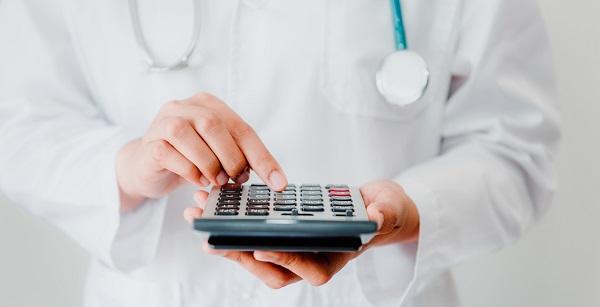Compensation in 2020 Survived COVID-19, CV Professionals Say
Federal support and boosts in pay from healthcare systems offset declines in patient and procedure volumes, a report shows.

The COVID-19 pandemic did indeed lead to a drop in patient encounters and procedure volumes in the cardiology realm in 2020, new survey data show. But overall, cardiovascular professionals did not see a major drop in their compensation.
Cardiologists within integrated practices (the vast majority of CV groups) saw a 4.9% decline in compensation in 2020 versus 2019, whereas those in private practices actually got a 1.8% bump up, according to the recently released ninth annual Cardiovascular Provider Compensation and Production Survey Report from MedAxiom, an American College of Cardiology company focused on performance improvement across cardiovascular organizations.
That’s despite proportionately larger declines in productivity—ie, procedures, office visits, imaging, and hospital rounds—as reflected by work relative value units (wRVUs), which dropped by 14.4% in integrated groups and by 12.8% in private groups last year.
The findings confirm predictions made during the summer of 2020 that the pandemic would have lingering effects on the business of cardiology lasting at least through the end of the year.
“We saw a significant decline in productivity. For sure, there was an acute decline and a recovery, but the net effect was a significant decline just as we thought,” said Jerry Blackwell, MD, MBA (Ballad Health, Kingsport, TN), president and CEO of MedAxiom.
Importantly, though, the report also provides “a reinforcement of the resiliency of the cardiovascular community and healthcare community,” he told TCTMD. He pointed out that the financial support of the federal government and the efforts of “health system partners that worked very hard with cardiovascular specialties on behalf of the patients” buffered cardiovascular groups from a major impact. “The work that was accomplished on behalf of the entire cardiovascular community, and healthcare in general, allowed organizations and groups that otherwise would have been in severe financial distress to actually weather the storm beautifully.”
Blackwell underscored that even though wRVUs fell in 2020, that doesn’t mean CV professionals weren’t working as much or weren’t feeling the strain of the pandemic along with everyone else. “In fact, there’s no doubt that the stress in the overall healthcare community actually went up during the pandemic,” he said.
In addition to government stimulus money, what allowed for the relatively small impact on physician pay despite the major reductions in patient visits and procedure volumes was that health systems started paying more per wRVU in recognition of the fact that physicians’ “productivity on behalf of society is not down,” Blackwell explained, noting that this is a temporary fix. “Demanding times require innovative and aggressive solutions, but . . . this is not a sustainable model.”
The COVID-19 Effect
The survey received responses from 188 practices with 4,982 cardiovascular professionals, including 2,565 full-time physicians, 1,935 advanced practice providers (APPs), and 482 part-time physicians. Median practice size was 10 full-time equivalent (FTE) physicians, with a drop in size from 2019 to 2020 in integrated groups (11.1 to 8.3) and growth among private practices (11.9 to 12.7).
The report provides detailed insights into the impact of COVID-19, showing that new patient volume took a big hit at the start of the pandemic with only a partial recovery by the end of 2020. In January 2020, the number of new patients per FTE cardiologist was 53. That number fell to as low as 28 in April before recovering. It reached a peak of 50 in October before declining to 44 by December. For the entire year, the number of new patients was a median of 545, lower than in 2019 (median 602).
I think it’s a very uplifting story, to be honest with you. Jerry Blackwell
Moreover, the median number of hospital discharges performed by cardiologists was nearly halved in 2020 versus 2019 (17 vs 30), with median hospital visits falling as well.
Among invasive and interventional procedures, diagnostic catheterization volumes were the lowest they’ve been since 2016, with 60 caths done per 1,000 active patients in 2020 (down from 69 the year before). PCI volumes, on the other hand, held steady at a median of 27 per 1,000 active patients.
In terms of compensation, even though it declined from 2019 for professionals in integrated settings, the median pay in 2020 ($612,216) was still the second-highest total over the past 5 years and remained higher than the median pay for those in private practice ($589,032). The highest-paying subspecialties remained electrophysiology (median $665,813) and interventional cardiology ($656,989).
Larger impacts were felt in terms of median wRVUs per cardiologist, which fell as low as 493 in April 2020, less than half of what it was at the beginning of the year (1,036). Numbers recovered, reaching a high of 1,001 in October, but there was an overall reduction in 2020 compared with 2019 (9,145 vs 10,455).
Looking Ahead
Asked to predict whether similar trends will be seen when data are available for 2021, which has seen a resurgence of COVID-19 around the world, Blackwell expressed uncertainty but noted that “many things have been put in place for cardiovascular specialists and the healthcare system in general that have allowed us to increase our volumes over what they were in a very safe fashion.” He pointed to greater comfort with telehealth and a better understanding of personal protection for clinicians, social distancing, and hygiene. Now, productivity is getting closer to normal levels, though it’s not there yet, he said.
Helping maintain productivity levels is growing reliance on APPs, a trend that continued through 2020. The median number of APPs per FTE physician was 0.57 last year, up from 0.39 in 2016. “Groups are getting much more efficient and understand both the value and the utility of advanced practice providers in the organization,” Blackwell said. “Many organizations that were using APPs not to the top of their license—in other words, they weren’t utilizing them maximally—in the pandemic have realized we’ve got to do things a little bit differently. So our notion is that folks have gotten smarter about how to get patients in and through their system and are using APPs more widely.”
Taking a broad view, Blackwell said the take-home message from the report is one of resiliency. “People just rallied to the cause on behalf of those we served. It was a most unusual time. . . . Nobody anywhere had a playbook about how to respond to this, yet as a community we really rallied around what needed to be done for patients and accomplished it. So I think it’s a very uplifting story, to be honest with you.”
Changes can be expected moving forward, he indicated. “There’s no doubt that the way we deliver cardiovascular care is being influenced by the macroenvironment, by technological evolution. And also, throughout the country we’re becoming more comfortable with the true value of team-based care, and I think that our increasingly connected world is allowing it to become easier to disseminate best care.”
Todd Neale is the Associate News Editor for TCTMD and a Senior Medical Journalist. He got his start in journalism at …
Read Full BioSources
MedAxiom. 2021 report: cardiovascular provider compensation and production survey: data from a global pandemic year. Published on: September 1, 2021. Accessed on: September 10, 2021.





Comments